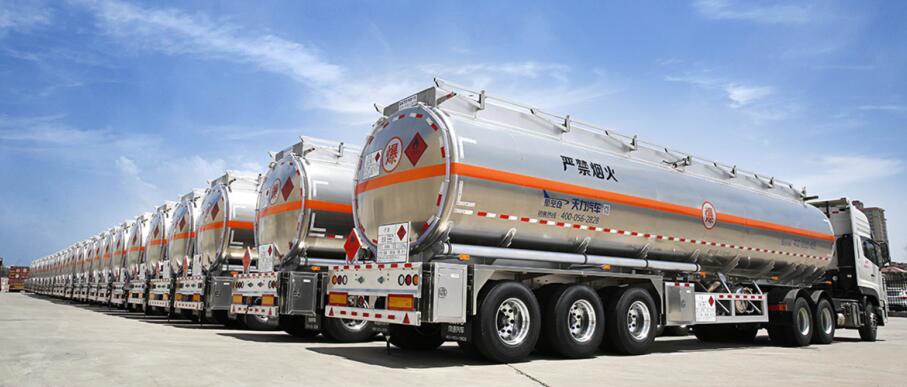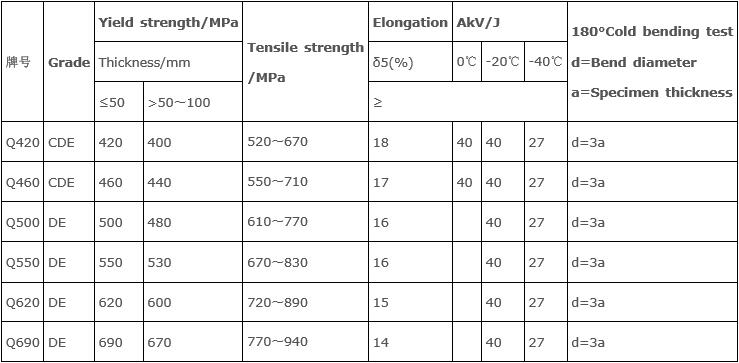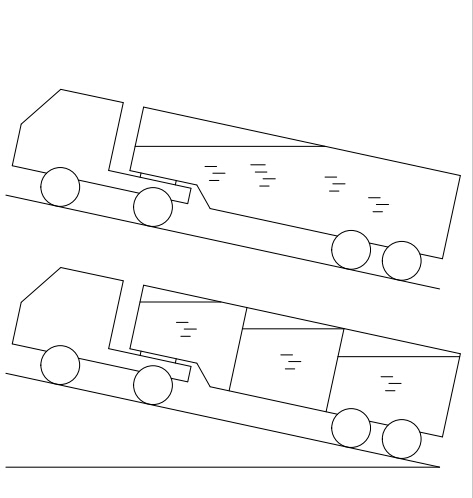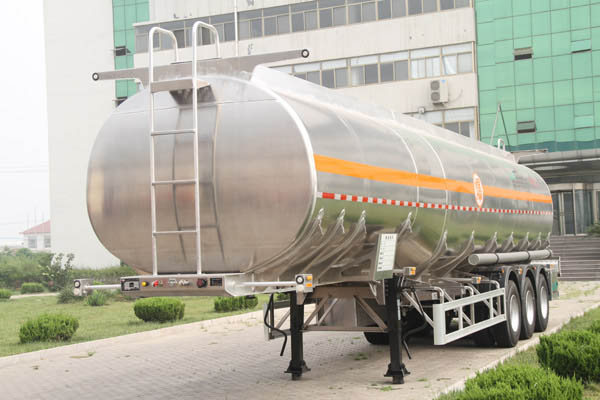A fuel tanker offers an effective means of handling and transporting liquid fuel. Usually, this type of tanker comes with different fuel storage compartments with a delivery pipe attached to the storage compartment of the tanker facilitating transfer of fuel.
The operations in a fuel tanker include filling the delivery fuel with fuel and transporting it through the delivery pipe.
Contact us, get more specs now!!
Fuel Tank Trailer Guide – Diesel, Petrol, Oil Tanker Trailers Designs & Specs

stainless steel tanker
Tanker Adaptation to Fuel Capacity
Regardless of the total capacity of the tanker, there will be compartments in each one of them to enhance the transportation of fuel from one destination to another.
Ideally, fueling tanker trucks are made of an elongated under-carriage frame with an elongated horizontal fuel storage tank with the sad compartments that are usually divided internally.
It is also important to note that these compartments usually have unequal volume capacities for storing and transporting fuel of different types and composition.
Fuel tankers are usually bottom loaded via either load only or through a load/unload couplers or adapters position below and in the direction of the center and longitudinally in the direction of the tanker undercarriage.
The average capacity of most fuel tankers ranges from 35 m3 to 50 m3. The ultimate capacity of the tanker is heavily dependent on the design and construction of each tanker.
The key determining aspects of how much a tanker can hold in terms of fuel capacity is the material used in its construction, the structure design, the thickness of the tanker walls, the built-in compartments and the strength of the frame upon which the tanker rests.
All these elements contribute to the final weight of the fuel tanker hence affecting the size and capacity of fuel to be transported through them. Here are some related to the capacity they can hold.
Contact us, get more specs now!!
1. Material
Different material selections for a fuel tanker would yield different results in terms of tank size and the capacity of each one of them. Light constructions give room for more fuel carrying capacity unlike with heavier constructions.
The two common materials used in the construction tankers are aluminum and steel. The most striking difference in characteristics between these two has to everything to do with the weight factor.
Ideally, steel is heavier than aluminum hence same tanker sizes of these different materials will lead to different weight carrying capacities.
Here are the results associated with a choice between an aluminum fuel tanker and a steel fuel tanker in terms of capacity.
- Aluminum
Fuel tanker manufacturing companies have been looking for ways to enhance efficiency in fuel transportation especially with the development of lighter components.
The philosophy of innovation is a reduction in weight of the fuel tanker to create room for more fuel to be carried onboard. The incorporation of light weight components has therefore been useful in the development of effective trailers and tractors.
In an effort to realize this, Aluminum is one of the basic materials that have been used. Although this is a perfect weight reduction approach, many manufacturing companies have shelved the opportunity owing to an increased production cost.
While the initial production aluminum fuel tankers may be high, it offers a longer term service than their steel counterparts because Aluminum does not corrode easily as steel would.

aluminum tank trailer
This is an added advantage on top of the ability to enhance the carrying capacity of fuel. Aluminum is lighter in weight compared to any other material used in the construction of fuel tankers.
This means that aluminum-made fuel tankers can hold a larger greater upper limit of even up to 60 m3.
- Steel
A fuel tanker of a steel construction with a comparable size to that of an aluminum construction will weigh more hence providing less room for fuel.
Due to the size and density, the steel tends to add a substantial weight onto the tanker construction. Steel fuel tankers are more economical and provide a stronger construction that that of the aluminum types.
The commonly used steel is 4-6 mm Q235 steel for the wave plates and tank body. The Q234 steel has stronger tenacity and higher elongation but it is not easy to be crispness.
Compared to the same size of an Aluminum tanker, a steel tanker would be heavier with zero weight of fuel. This means that the loaded fuel in both cases for a similar structure would be different with the steel option providing a lesser volume capacity.
Actually, it is not the carrying capacity that is affected alone. A reduction in total weight of the fuel tanker leads to a reduction in transportation costs since the consumption rate also goes down.
Therefore, adjustments can be made to replace the more fuel needed for a steel tanker with the loaded weight hence enhancing the efficiency of transportation.

Material strength
Contact us, get more specs now!!
Choosing Between Steel and Aluminum Fuel Tankers
Steel fuel tankers are usually a stronger construction in terms of withstanding weight compared to those of an aluminum construction. This is an important factor to note in your choice of the trailer you would want.
If you have to go for this choice, it should be behind a good reason of forgoing fuel capacity efficiency. Again, the steel option is cheaper compared to the aluminum one due to the manufacturing processes involved.
It is easier to manufacture with steel than aluminum especially on welding possibilities. However, steel is easily corroded unlike aluminum.
On the other hand, aluminum offers the best fuel capacity by volume due to its light weight. The main challenge with an aluminum tanker is the costs due to complexities involved in welding aluminum.
However, if you are making a consideration of how much of fuel to transport at ago, then this would be the best option for you. It will increase your cost efficiencies during operations.
2. Structure
Different shapes have different upper limits. This determines how well fuel can be balanced in them to facilitate safe fuel transportation. For instance, the Ellipse structures have a lower gravity center.
For that reason, it can be longer than the round and round square structures.
Enhanced stability implies an ability to withstand a heavier load and manage loading, transportation and offloading operations without concerns of tipping over and causing accidents.
Enhanced stability through a structural design will ensure faster deliveries because the tanker can be transported at a faster speed than one whose stability is not good enough.
Ideally, fuel tank trailers are available in different shapes such as circle, ellipse, and rectangular shapes. The shape of the fuel tanker determines how stable and balanced the tanker will be during operations.
Their height to gravity ratio is 1:0.79:0.65. A large fuel tanker means that it will have a bigger capacity for transporting your fuel. For that reason, they have an ellipse and round rectangular shape because of the need for stability.
The low center of gravity in this shape keeps the trailer stable.

ellipse tank trailer
Another factor to consider when looking at the structure is the pressure of loading and transportation of your fuel. If the types of fuel you want to transport needs high pressure tanks, make sure you go for those that are built using the circle shape.
This ensures uniform pressure distribution and most importantly, they can withstand high pressure.
Contact us, get more specs now!!
3. Thickness of tank
How much of fuel do you want to transport in one trip? If it is just a small amount, you may not need a thick wall for your fuel tanker. Well, remember this is independent of the material you have chosen.
Whether it is a steel fuel tanker or aluminum one doesn’t matter. When it comes to the amount of fuel to be transported, the thickness of the tanker is the next factor to consider.
If you want to transport big amount of fuel, then remember that fuel tanks with a large capacity need thicker material plate to work under pressure and most importantly, keep the tank safer.
More fuel exerts more pressure and therefore, you need to compensate that with the right wall thickness of your fuel tanker.
This is especially in the event of an accident occurring on the large capacity tank – you will be assured that your tanker will withstand the impact result from the same.

Fuel Tank Trailer
4. Compartments, Wave Baffle
Capacity of tank trailer determines the maximum number of compartments and max capacity of each compartment. The function of the tanker baffles is to control liquid surge during transport.
They are generally welded inside the tank and, over a period of time, can break down or fail. When baffles are broken or become ineffective, liquid surge poses a very serious hazard.

how multi-compartments work
Consequently, the size of the tanker will definitely be determined by the number of compartments on your fuel tanker.
Each baffle should be accessible through a manhole to allow inspection and maintenance work. Large compartments (usually in excess of 2.5 meters) of tanks should be fitted with baffles.

wave battles
The distance between a bulkhead and a baffle should not exceed 2.5 meters.
Where multiple baffles are required to satisfy the 2.5 meters spacing requirements, the surface area of the baffles should not be less than 70 per cent of the maximum area of the cross section.
This means that the final capacity of the tanker will determine what extra components to be added on. Therefore, it is important to know how much of fuel you want to transport with your choice of fuel tanker.
There are many aspects that come into place as highlighted here.
Contact us, get more specs now!!
5. Frame
More fuel volume capacity means more weight. As a result, the tanker needs a stronger main frame capable of coping with such a capacity. Here are important requirements in such an application:
- The main frame should combine with tank closely. This close connection ensures uniform balancing and stability of the entire fuel tanker structure. In such a set up, the center of gravity is kept as low as possible hence making the operations safe.
- It should be of high strength material. Enough strength is needed to take the weight of high fuel capacity. Liaise with your tanker manufacturer to establish whether the frame is of a strong construction.
- It requires a strong design and high quality welding for the frame. High-quality welds are important to ensure good strength for the frame. Conduct a standard weld inspection procedure guided by an expert to ensure you are getting well-fabricated frames for your fuel tanker.
Conclusion
A successful choice of your fuel tanker for the amount of fuel you want to transport is a multifaceted process that tags along other aspects. Your choice of the desirable capacity will be informed by a number of factors:
material of tanker construction, the design of the structure, the thickness requirements for different capacities, number of compartments required and the quality of frame for the structure.
Steel and aluminum have widely been used in the construction of fuel tankers but each has its own benefits with the aluminum option giving you a much bigger capacity option due to its light weight factor.
Your capacity requirements will dictate the final choice of tanker to go for. Whether to choose between steel and aluminum is all based upon all these factors outlined in here defining the capacity requirements for all fuel tankers.

